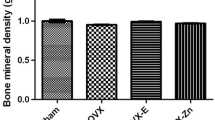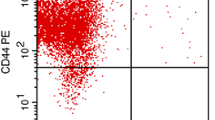Abstract
Decreased osteoblastic activity seems to play an important role in the pathogenesis of postmenopausal osteoporosis. The aim of the present study was to examine the direct effects of human growth hormone (GH) on proliferation and differentiation of osteoblastic cells obtained from patients with postmenopausal osteoporosis and age-matched normals and to compare the cellular responses induced by GH between the two groups. Osteoblast cultures (human marrow stromal osteoblast-like cells) were established from bone marrow aspirates obtained from 9 osteoporotic patients and 12 age-matched normals. Effects on cell proliferation and cell differentiation markers [alkaline phosphatase (AP)], procollagen type I propeptide (PICP), and osteocalcin] were assessed. GH stimulated 3H-thymidine incorporation into DNA in cell cultures of osteoporotic patients to a maximum of 158±14% of no-treatment controls (n=9, P<0.001) and to 203±52% (n=9, P<0.001) in normals. GH increased cell number as measured by methylene blue (MB) assay in cells of osteoporotic patients to 138±10% (P< 0.05, n=7) and in normals to 138±12 (P<0.05, n=7). GH alone reduced cellular AP production: 61±3.8% (P<0.05, n=7) versus 65±16% (P<0.05, n=7) and cellular PICP production: 79±6% (P<0.05, n=7) versus 69±16% (n.s., n=7), in cell cultures of osteoporotics and normals, respectively. 1,25-dihydroxy vitamin D3 (1,25(OH)2D3) (10-9 M) alone increased AP production in cell cultures of osteoporotics to 193±23% (P<0.01, n=7) and to 266±51% (P<0.05, n=7) in cell cultures of normals. 1,25(OH)2D3 had no effect on PICP production in either culture. Combining GH and 1,25(OH)2D3 reduced 1,25(OH)2D3-stimulated levels of AP and osteocalcin. No statistically significant differences were observed in cell proliferation or cell differentiation responses between cell cultures of osteoporotic patients and normals. Our results demonstrate that osteoblastic cells obtained from osteoporotic patients exhibit normal responsiveness to short-term stimulation with GH in vitro and do not support the hypothesis of the presence of major defects in osteoblastic responsiveness to stimuli in patients with osteoporosis.
Similar content being viewed by others
References
Eriksen EF, Hodgson SF, Eastell R, Cedel SL, O'Fallon WM, Riggs L (1990) Cancellous bone remodeling in type I (postmenopausal) osteoporosis: quantitative assessment of rates of formation, resorption, and bone loss at tissue and cellular levels. J Bone Miner Res 5:311–319
Cohensolal ME, Shih MS, Lundy MS, Parfitt AM, (1991) A new method for measuring cancellous bone erosion depth-application to the cellular mechanisms of bone loss in post-menopausal osteoporosis. J Bone Miner Res 6:1331–1338
Darby AJ, Meunier PJ (1981) Mean wall thickness and formation periods of trabecular bone packets in idiopathic osteoporosis. Calcif Tissue Int 33:199–204
Parfitt AM (1988) Bone remodeling: relationship to the amount and structure of bone and the pathogenesis and prevention of fractures. In: Riggs BL, Melton LJ (eds) Osteoporosis: etiology, diagnosis and management. Raven Press, New York, p 45
Marie PJ, Sabbagh A, Vernejoul MC, Lomri A (1989) Osteocalcin and deoxyribonucleic acid synthesis in vitro and histomorphometric indices of bone formation in postmenopausal osteoporosis. J Clin Endocrinol Metab 69:272–279
Lomri A, Marie PJ (1990) Bone cell responsiveness to transforming growth factor B, parathyroid hormone and prostaglandin E2 in normal and postmenopausal osteoporotic women. J Bone Miner Res 5:1149–1155
Marie PJ, Devernejoul MC, Connes D, Hott M (1991) Decreased DNA synthesis by cultured osteoblastic cells in eugonadal osteoporotic men with defective bone formation. J Clin Invest 88:1167–1172
Raisz LG (1988) Local and systemic factors in the pathogenesis of osteoporosis. N Engl J Med 318:818–828
Brixen K, Nielsen HK, Mosekilde L, Flyvbjerg A (1990) A short course of recombinant human growth hormone treatment stimulates osteoblasts and activates bone remodelling in normal human volunteers. J Bone Miner Res 5:609–618
Kassem M, Blum W, Risteli J, Mosekilde L, Eriksen EF (1993) Growth hormone stimulates proliferation and differentiation of human osteoblast-like cells in vitro. Calcif Tissue Int 52:222–226
Slootweg MC, Buul-Offers SC, Herrmann-Erlee MPM, van der Meer JM, Duursma SA (1988) Growth hormone is mitogenic for fetal mouse osteoblasts but not for undifferentiated bone cells. J Endocrinol 118:294–300
Barnard R, Ng KW, Martin TJ, Waters MJ (1991) Growth hormone (GH) receptors in clonal osteoblast-like cells mediate a mitogenic response to GH. Endocrinology 128:1459–1464
Wergedal JE, Mohan S, Lundy M, Baylink DJ (1990) Skeletal growth factors and other growth factors known to be present in bone matrix stimulate proliferation and protein synthesis in human bone cells. J Bone Miner Res 5:179–186
Ebeling PR, Jones JD, Janes CH, Lane AW, O'Fallon WM, Riggs BL (1992) Short-term effects of recombinant human insulin-like growth factor-I on bone turnover in normal women (abstract). J Bone Miner Res 7(suppl)1:s138
Kassem M, Risteli L, Mosekilde L, Melsen F, Eriksen EF (1991) Formation of osteoblast-like cells from human mononuclear bone marrow cultures. APMIS 99:269–274
Oliver MH, Harrison NK, Bishop JE, Cole PJ, Laurent GJ (1989) A rapid and convenient assay for counting cells cultured in microwell plates: application for assessment of growth factors. J Cell Sci 92:513–518
Melkko J, Niemi S, Risteli L, Risteli J (1990) Radioimmunoassay of the carboxyterminal propeptide of human type I procollagen. Clin Chem 36:1328–1332
Feldman HA (1988) Families of lines: random effects in linear regression analysis. J Appl Physiol 64:1721–1732
Macieira-Coelho A (1988) Biology of normal proliferating cells in vitro: relevance for in vivo aging. Krager, Basel
Owen M (1985) Lineage of osteogenic cells and their relationship to the stromal system. In: Peck WA (ed) Bone and mineral research/annual 3. Elsevier, Amsterdam, p 1
Long MW, Williams JL, Mann KG (1990) Expression of human bone-related proteins in the hematopoietic microenvironment. J Clin Invest 86:1387–1395
Haynesworth SE, Goshima J, Goldberg VM, Caplan AI (1992) Characterization of cells with osteogenic potential from human marrow. Bone 13:81–88
Gerstenfeld LC, Chipman SD, Glowacki J, Lian JB (1987) Expression of differentiated function by mineralizing cultures of chicken osteoblasts. Dev Biol 122:49–60
Charles P, Poser JW, Mosekilde L, Jensen FT (1985) Estimation of bone turnover evaluated by 47Ca-kinetics efficiency of serum bone gamma-carboxyglutamic acid-containing protein, serum alkaline phosphatase, and urinary hydroxyproline excretion. J Clin Invest 76:2254–2258
Risteli L, Risteli J (1990) Noninvasive methods for detection of organ fibrosis. In: Rojkind M (ed) Connective tissue in health and disease, vol. 1. CRC Press, Boca Raton, p 61
Delmas PD (1988) Biochemical markers of bone turnover in osteoporosis. In: Riggs BL, Melton LJ (eds) Osteoporosis: etiology, diagnosis and management. Raven Press, New York, p 297
Green H, Morikawa M, Nixon T (1985) A dual effector theory of growth-hormone action. Differentiation 29:195–198
Owen TA, Aronow M, Shalhoub V, Barone LM, Wilming L, Tassinari MS, Kennedy MB, Pockwins S, Lian JB, Stein GS (1990) Progressive development of the rat osteoblast phenotype in vitro: reciprocal relationships in expression of genes associated with osteoblast proliferation and differentiation during formation of the bone extracellular matrix. J Cell Physiol 143:420–430
Author information
Authors and Affiliations
Rights and permissions
About this article
Cite this article
Kassem, M., Brixen, K., Mosekilde, L. et al. Human marrow stromal osteoblast-like cells do not show reduced responsiveness to In vitro stimulation with growth hormone in patients with postmenopausal osteoporosis. Calcif Tissue Int 54, 1–6 (1994). https://doi.org/10.1007/BF00316280
Received:
Accepted:
Issue Date:
DOI: https://doi.org/10.1007/BF00316280




